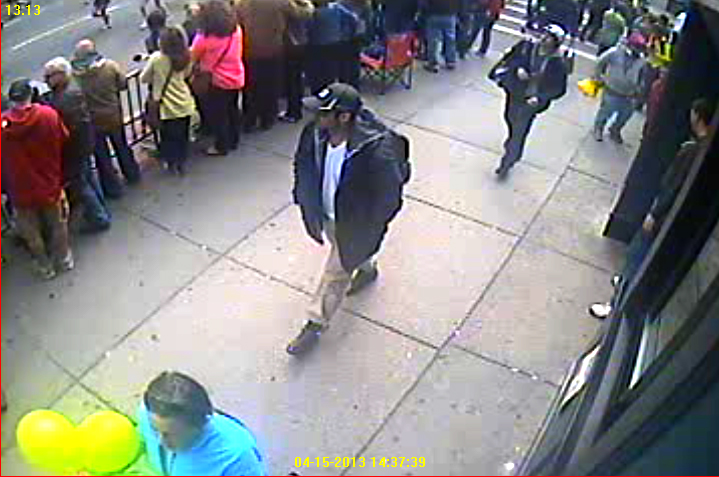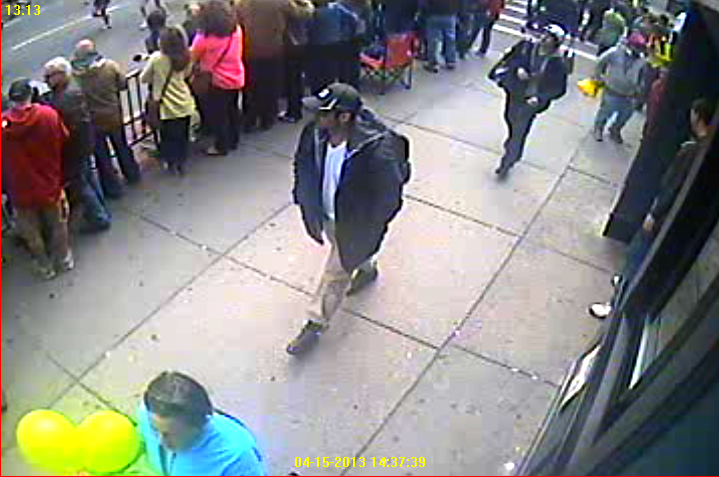
On Thursday, April 18, the special agent in charge of the Boston Division of the FBI appeared on television to release high-definition cell-phone images captured by bystanders and examined by agents trained to read facial expressions, and closed circuit surveillance video footage showing two young men carrying backpacks believed to be the prime suspects in the Boston Marathon bombings on Monday, April 15, that killed three people and injured more than 170 others. The men were identified only as “Suspect 1,” wearing a black hat, and “Suspect 2,” wearing a white hat. They appeared “to be walking together through the marathon crowd on Boylston Street in the direction of the finish line.” Special agent Richard DesLauriers displayed the images on pasteboard posters as if at a trade fair or as part of a high school science project, but they were also released on the FBI website, “posted for the public and media to use, review, and publicize.”
“For more than 100 years,” said special agent DesLauriers, “the FBI has relied on the public to be its eyes and ears. With the media’s help, in an instant, these images will be delivered directly into the hands of millions around the world. We know the public will play a critical role in identifying and locating them.” As soon as the images appeared online, the site was inundated with tips and inquiries. The size of the net cast in the search for the as-yet-unnamed suspects had instantly increased by a factor of millions.
At the same time, the FBI agent tried to control the multiplier: “For clarity, these images should be the only ones—the only ones—that the public should view to assist us. Other photos should not be deemed credible and unnecessarily divert the public’s attention in the wrong direction and create undue work for vital law enforcement resources.”
The overall coverage rate of images has increased considerably since 9/11. The volume of data files, of unstructured digital imagery from mobile devices and ubiquitous surveillance cameras, for any given event, is staggering. From the moment of the blasts in Boston, and before, the number of still and moving images recorded provided nearly complete coverage. At this point, analysis technology is struggling to keep up with collection technology. The often-repeated claim by law enforcement officials that “there’s no such thing as too much evidence” is being sorely tested.
FBI officials would later say that the decision to release the images of the suspects was made at the highest levels, including Attorney General Eric H. Holder Jr. and Director of the FBI Robert S. Mueller III, because the search for the killers had stalled. The release of the images set off a series of events that transpired over the next 26 hours, leaving one police officer and one of the suspects dead, several other officers gravely wounded, and one of the nation’s major cities locked down.
It appears that crowd-sourcing did not lead directly to the apprehension of the suspects, but the barrage of images may have flushed them out into the open.
Terror, like its father, war, is all about destroying bodies. If bodies are not distressed, maimed, and killed, it’s not doing its job. The Brothers Tsarnaev did most of their infernal work all at once, with two timed explosions of low-tech shrapnel-packed IEDs spraying mayhem into a crowd of onlookers. Whereas the 9/11 terrorists hit high and rained down destruction, the Boston bombers hit low and spread out, crippling victims from the waist down, an especially horrific assault tactic in the context of a running event.
Afterward, the images of Boston under siege showed most Americans, for the first time, the face of the new post-9/11 Homeland Security state, with military-level armaments and armored vehicles, surveillance helicopters equipped with thermal imaging technology to detect human bodies under cover, and overwhelming firepower. Shock and Awe had come home to our own backyards, mobilized in the end to track down one 19-year old college student. This was a different kind of multiplier effect: an attempt was made to clear the streets of the city, to get everyone to “shelter in place” and become spectators alone in front of their screens.
After the older brother was killed in a ferocious firefight, and law enforcement was closing in on the younger brother, someone made a grisly autopsy image of the slain terrorist, naked, battered, and bloody, and emailed it around to first responders, to act as confirmation. Then it went viral on the Net and had a different effect, as vengeance pornography, unleashing a torrent of sneers and slurs in an orgy of virtual vigilantism.
The larger autopsy has only begun, of course, and the questions are many. Some of the most pressing are about how images are operating now, in a changed environment, and how the new faces of terrorism are mirroring or tracking the features of our relation to images—shifting from the organized and coherent structures of institutional bodies to atomized, alienated individuals acting alone.
David Levi Strauss is the author of From Head to Hand: Art and the Manual (Oxford University Press, 2010), Between the Eyes: Essays on Photography and Politics, with an introduction by John Berger (Aperture 2003), Between Dog & Wolf: Essays on Art and Politics (Autonomedia 1999), and the forthcoming Words Not Spent Today Buy Smaller Images Tomorrow. He is Chair of the MFA program in Art Criticism & Writing at the School of Visual Arts in New York.
Strauss previously wrote for LightBox on The Art of the Altered Image, James Nachtwey’s unpublished 9/11 photographs and an analysis of top-level decisions to withhold sensitive imagery.

More Must-Reads from TIME
- Donald Trump Is TIME's 2024 Person of the Year
- Why We Chose Trump as Person of the Year
- Is Intermittent Fasting Good or Bad for You?
- The 100 Must-Read Books of 2024
- The 20 Best Christmas TV Episodes
- Column: If Optimism Feels Ridiculous Now, Try Hope
- The Future of Climate Action Is Trade Policy
- Merle Bombardieri Is Helping People Make the Baby Decision
Contact us at letters@time.com